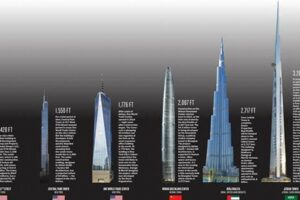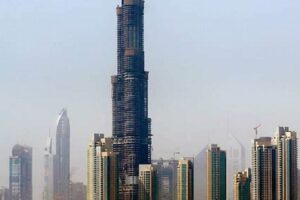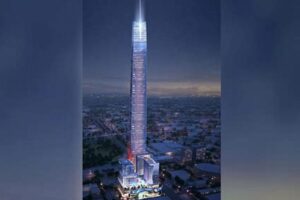Skyscrapers have become a symbol of human ambition and architectural ingenuity, with the world’s tallest structures reaching beyond the clouds and reshaping skylines around the globe. These architectural marvels are not just vertical wonders; they are testaments to engineering prowess and beacons of economic prosperity.
The benefits of building skyscrapers are numerous. They allow for efficient land use in densely populated urban areas, providing more space for housing, businesses, and public amenities. Skyscrapers also offer unparalleled views, create iconic landmarks, and serve as symbols of a city’s economic power and prestige. Historically, the construction of skyscrapers has been driven by technological advancements, particularly in the development of elevators, structural materials, and construction techniques.
In this article, we will explore the world’s tallest skyscrapers beyond the clouds, examining their architectural features, engineering challenges, and the impact they have on the cities they call home. We will also discuss the future of skyscraper construction, as architects and engineers push the boundaries of design and innovation to create even taller and more sustainable structures.
1. Height
The height of the world’s tallest skyscrapers is a testament to the ingenuity and innovation of structural engineers. These giants soar upwards, seemingly defying gravity, and push the limits of what is structurally possible. To achieve these incredible heights, engineers employ a variety of techniques, including:
- Supertall steel frames: These frames are made of high-strength steel and are designed to withstand the immense weight of the building and the forces of wind and earthquakes.
- Concrete core walls: These walls are made of reinforced concrete and provide the building with stability and strength.
- Outrigger systems: These systems are made of steel beams that extend from the core of the building to the exterior walls. They help to distribute the weight of the building and reduce the amount of sway caused by wind.
- Tuned mass dampers: These devices are placed at the top of the building and help to reduce sway by counteracting the movement of the building with their own weight.
The result of all this engineering prowess is a new generation of skyscrapers that are taller than ever before and that are able to withstand the most extreme conditions. These buildings are a testament to the human spirit and our ability to push the boundaries of what is possible.
2. Design
The design of the world’s tallest skyscrapers is not just about creating a structure that can reach for the clouds; it is also about creating a work of art. These buildings are designed to be iconic landmarks, and their forms and facades reflect the innovation and aesthetic grandeur of their architects. In many ways, the design of these skyscrapers is just as important as their height.
One of the most important aspects of skyscraper design is the use of innovative materials and construction techniques. These buildings are often constructed using new and untested materials, and their engineers must find ways to make them strong enough to withstand the forces of wind and earthquakes. The facades of these buildings are also often made of unique and eye-catching materials, such as glass, metal, and stone.
Another important aspect of skyscraper design is the use of sustainable features. These buildings are often designed to be energy-efficient and environmentally friendly. They may use solar panels to generate electricity, and they may have rainwater collection systems to reduce water usage. Some skyscrapers are even designed to be LEED-certified, which means that they meet certain environmental standards.
The design of the world’s tallest skyscrapers is a complex and challenging process, but it is also a rewarding one. These buildings are not just vertical wonders; they are also works of art that can inspire and amaze people around the world.
3. Engineering
The engineering of the world’s tallest skyscrapers is a complex and challenging undertaking. These buildings are not just vertical wonders; they are also feats of engineering prowess. To achieve these incredible heights, engineers must carefully consider every aspect of the building’s design and construction, from the materials used to the structural systems employed.
- Structural systems: The structural system of a skyscraper is responsible for transferring the weight of the building to the ground. In the case of the world’s tallest skyscrapers, this is no easy task. Engineers must design structural systems that can withstand the immense weight of the building, as well as the forces of wind and earthquakes.
- Materials: The materials used in the construction of a skyscraper also play a vital role in its structural integrity. The world’s tallest skyscrapers are typically constructed using a combination of steel, concrete, and glass. Steel is used for its strength and durability, while concrete is used for its ability to withstand compression. Glass is used for its transparency and ability to let in natural light.
- Construction techniques: The construction of a skyscraper is a complex and time-consuming process. Engineers must carefully plan and execute each step of the construction process, from the foundation to the top of the building. In the case of the world’s tallest skyscrapers, this process can take several years to complete.
- Safety: Safety is a paramount concern in the construction of any building, but it is especially important in the construction of skyscrapers. Engineers must take into account a variety of safety factors, including the wind, the weather, and the potential for earthquakes. They must also design the building in such a way that it is safe for occupants in the event of a fire or other emergency.
The engineering of the world’s tallest skyscrapers is a remarkable achievement. These buildings are a testament to the ingenuity and creativity of engineers, and they continue to push the boundaries of what is possible in architecture and engineering.
4. Sustainability
As the world’s tallest skyscrapers soar beyond the clouds, their designs increasingly prioritize sustainability, demonstrating a commitment to environmental consciousness. Architects and engineers are incorporating innovative green technologies to minimize the environmental impact of these towering structures.
- Energy efficiency: Skyscrapers can consume vast amounts of energy, but many of the world’s tallest buildings are now designed to be energy efficient. They may use energy-efficient lighting systems, appliances, and HVAC systems. Some skyscrapers even generate their own renewable energy through solar panels or wind turbines.
- Water conservation: Water conservation is another important aspect of sustainable skyscraper design. Many of the world’s tallest buildings are equipped with rainwater harvesting systems and low-flow plumbing fixtures. Some skyscrapers even recycle wastewater for use in irrigation or cooling systems.
- Green materials: The materials used in the construction of skyscrapers can also have a significant environmental impact. Many of the world’s tallest buildings are now constructed using recycled materials and materials with low embodied carbon. Some skyscrapers even use plants and other natural elements in their facades to improve air quality and reduce energy consumption.
- Green certifications: Many of the world’s tallest skyscrapers are now certified under green building rating systems, such as LEED and BREEAM. These certifications provide independent verification of a building’s environmental performance and encourage the adoption of sustainable design practices.
The incorporation of green technologies in the world’s tallest skyscrapers demonstrates a growing commitment to sustainability in the construction industry. These buildings are not only architectural marvels but also environmental leaders, setting an example for other buildings to follow.
5. Urban impact
The construction of world’s tallest skyscrapers beyond the clouds has a profound impact on the urban environment, transforming cityscapes and redefining urban planning and density. These towering structures are not just vertical wonders; they are also catalysts for urban development and economic growth.
- Increased density: Skyscrapers allow for a more concentrated and efficient use of land in densely populated urban areas. By building upwards, cities can accommodate more people and businesses without expanding their physical footprint.
- Mixed-use development: Skyscrapers often incorporate a mix of uses, such as residential, commercial, and retail, creating vibrant and diverse urban environments. This mixed-use development can help to reduce traffic congestion and create more walkable and livable cities.
- Economic growth: Skyscrapers can be a major driver of economic growth, attracting businesses, investment, and tourism. They can also create jobs and boost local economies.
- Urban landmarks: Skyscrapers are often iconic landmarks that define a city’s skyline and create a sense of place. They can also be a source of civic pride and attract visitors from around the world.
The impact of skyscrapers on the urban environment is complex and multifaceted. However, one thing is clear: these towering structures are playing an increasingly important role in shaping our cities and the way we live.
6. Economic drivers
In the realm of urban development, the construction of world’s tallest skyscrapers beyond the clouds has emerged as a powerful economic driver, attracting businesses, investment, and tourism, reshaping city skylines and transforming economies.
- Business Hubs and Corporate Headquarters: Skyscrapers provide prestigious and state-of-the-art facilities that cater to the needs of multinational corporations and leading businesses. Their height and iconic status often symbolize economic power and global reach, making them desirable locations for company headquarters and regional offices.
- Tourism and Hospitality: World’s tallest skyscrapers often become major tourist attractions, drawing visitors from around the world. Observation decks, restaurants, and other amenities located at dizzying heights offer unparalleled views of the city and surrounding areas, generating revenue and supporting the local hospitality industry.
- Investment Opportunities: Skyscrapers represent significant investment opportunities, attracting both domestic and international investors. Their value as landmarks and their potential for rental income make them attractive assets for real estate portfolios and investment funds.
- Job Creation and Economic Multiplier: The construction and maintenance of skyscrapers create numerous jobs in various sectors, including architecture, engineering, construction, and property management. This, in turn, has a multiplier effect, stimulating the local economy and generating additional employment opportunities.
These economic drivers play a crucial role in the development and prosperity of cities. World’s tallest skyscrapers beyond the clouds not only define skylines but also serve as catalysts for economic growth, innovation, and global recognition.
7. Cultural icons
World’s tallest skyscrapers beyond the clouds transcend their architectural significance to become cultural icons, deeply intertwined with the civic pride and national identity of their and countries. These towering structures embody the aspirations, achievements, and ambitions of the people they represent, serving as powerful symbols of progress and human ingenuity.
The connection between world’s tallest skyscrapers and cultural icons is evident in several ways. Firstly, these skyscrapers often reflect the cultural values and aspirations of the societies that built them. For example, the Burj Khalifa in Dubai embodies the region’s drive for modernization and economic growth. Similarly, the Shanghai Tower in China symbolizes the country’s rapid urbanization and technological advancement.
Moreover, world’s tallest skyscrapers have become landmarks that define city skylines and national identities. They are sources of pride for local communities and represent the achievements of a nation on the global stage. The Empire State Building in New York City, for instance, has become an iconic symbol of American ambition and economic power. The Petronas Towers in Kuala Lumpur are synonymous with Malaysia’s economic and architectural prowess.
The cultural significance of world’s tallest skyscrapers is not merely symbolic. These structures have a tangible impact on the cultural life of cities and nations. They attract tourists from around the world, generate revenue for local businesses, and serve as venues for cultural events and exhibitions. The observation decks of these skyscrapers offer breathtaking views, allowing visitors to experience the city from a unique perspective and appreciate its architectural beauty.
In conclusion, the connection between world’s tallest skyscrapers and cultural icons is profound and multifaceted. These structures are not just architectural marvels; they are symbols of civic pride, national identity, and human ambition. Their cultural significance extends beyond their physical presence, shaping the cultural landscape of cities and nations, and inspiring awe and admiration in people around the world.
Frequently Asked Questions (FAQs) about World’s Tallest Skyscrapers Beyond the Clouds
This section addresses common questions and misconceptions surrounding the world’s tallest skyscrapers, providing concise and informative answers.
Question 1: What are the key factors that contribute to the height of these skyscrapers?
The height of the world’s tallest skyscrapers is primarily determined by advancements in structural engineering, the use of innovative materials, and the implementation of sophisticated construction techniques. Engineers employ supertall steel frames, concrete core walls, and outrigger systems to withstand the immense weight and lateral forces acting on these structures.
Question 2: How do these skyscrapers maintain stability and resist strong winds?
Skyscrapers employ various strategies to ensure stability and resist strong winds. Tuned mass dampers, located at the top of the building, counteract sway by moving in opposition to the building’s motion. Additionally, the use of wind turbines and aerodynamic shaping helps to reduce wind resistance and improve stability.
Question 3: What measures are taken to ensure the safety of occupants in these high-rise buildings?
Safety is paramount in the design and construction of world’s tallest skyscrapers. Fire safety systems, including sprinklers, fire alarms, and evacuation plans, are meticulously implemented. Moreover, advanced seismic engineering techniques are employed to withstand earthquakes and minimize structural damage.
Question 4: How do these skyscrapers contribute to sustainable urban development?
Modern skyscrapers increasingly incorporate sustainable features to reduce their environmental impact. They utilize energy-efficient lighting, appliances, and HVAC systems. Water conservation measures, such as rainwater harvesting and low-flow plumbing fixtures, are also implemented. Some skyscrapers even generate renewable energy through solar panels or wind turbines.
Question 5: What are the economic benefits of constructing these ultra-tall buildings?
Skyscrapers serve as catalysts for economic growth by attracting businesses, investment, and tourism. They provide prestigious office spaces, accommodate mixed-use developments, and become landmarks that enhance the city’s global recognition. The construction and maintenance of these skyscrapers generate employment opportunities and stimulate various sectors of the economy.
Question 6: How do these skyscrapers impact the urban landscape and surrounding environment?
The presence of world’s tallest skyscrapers significantly transforms urban landscapes, creating iconic landmarks and reshaping skylines. They optimize land use in densely populated areas and promote vertical development. However, their construction and operation must consider environmental factors to minimize their ecological footprint and ensure the well-being of surrounding communities.
These FAQs provide a glimpse into the fascinating world of the world’s tallest skyscrapers beyond the clouds, addressing key concerns and highlighting their engineering marvels, safety measures, sustainability efforts, economic significance, and urban impact.
Transition to the next article section:
As we continue to push the boundaries of architectural innovation, the future of skyscrapers promises even more awe-inspiring structures that will redefine our cities and shape the skylines of tomorrow.
Tips for Constructing World’s Tallest Skyscrapers Beyond the Clouds
The construction of world’s tallest skyscrapers beyond the clouds presents unique challenges and requires meticulous planning and execution. Here are several essential tips to ensure the successful design and construction of these architectural marvels:
Tip 1: Prioritize Structural Integrity
Structural integrity is paramount in skyscraper construction. Employ robust structural systems, such as supertall steel frames and concrete core walls, to withstand immense weight and lateral forces. Utilize advanced engineering techniques, including wind turbines and tuned mass dampers, to enhance stability and resist strong winds.Tip 2: Implement Sustainable Practices
Incorporate sustainable features to minimize the environmental impact of skyscrapers. Utilize energy-efficient systems, install water conservation fixtures, and consider renewable energy sources such as solar panels or wind turbines. Strive for green building certifications to demonstrate commitment to environmental stewardship.Tip 3: Enhance Safety Measures
Safety should be a top priority in skyscraper design. Implement comprehensive fire safety systems, including sprinklers, fire alarms, and evacuation plans. Employ advanced seismic engineering techniques to withstand earthquakes and minimize structural damage. Regular maintenance and inspection are crucial to ensure ongoing safety.Tip 4: Optimize Space Utilization
Maximize space utilization in densely populated urban areas. Design skyscrapers with mixed-use developments that combine residential, commercial, and retail spaces. Utilize vertical transportation systems, such as high-speed elevators, to efficiently move occupants throughout the building.Tip 5: Consider Urban Impact
Skyscrapers have a significant impact on the urban landscape. Plan for seamless integration with surrounding infrastructure and transportation networks. Conduct thorough environmental assessments to minimize ecological impact and promote sustainable urban development.
These tips provide guidance for architects, engineers, and developers involved in the construction of world’s tallest skyscrapers beyond the clouds. By adhering to these principles, we can create structures that are not only architectural marvels but also safe, sustainable, and beneficial to the urban environment.
Conclusion:
The pursuit of constructing world’s tallest skyscrapers beyond the clouds is a testament to human ingenuity and architectural prowess. By embracing innovative design, sustainable practices, and a commitment to safety and urban well-being, we can continue to push the boundaries of vertical development and create awe-inspiring structures that shape the future of our cities.
Conclusion
In exploring the world’s tallest skyscrapers beyond the clouds, we have journeyed through engineering marvels, architectural innovations, and sustainable practices. These towering structures stand as testaments to human ambition and ingenuity, reshaping skylines and transforming urban landscapes.
As we continue to push the boundaries of vertical development, the future of skyscrapers holds endless possibilities. By embracing cutting-edge technologies, sustainable solutions, and a commitment to urban well-being, we can create structures that not only reach for the heavens but also contribute positively to our cities and the environment. The pursuit of world’s tallest skyscrapers beyond the clouds is an ongoing endeavor, one that will continue to inspire awe and drive innovation for generations to come.







